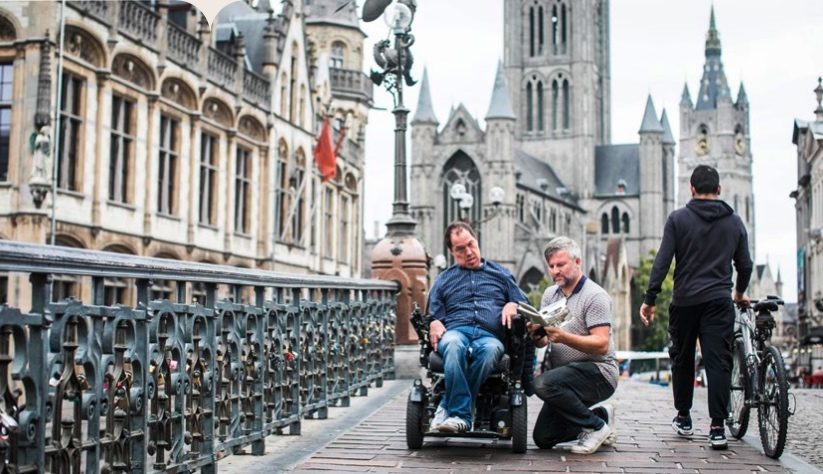The city of Ghent has launched a tourist itinerary for hearing and visually impaired visitors, as reported by Belgian news outlet VRT. The campaign includes special booklets which contain tactile pictures of seven attractions in the historic center of Ghent, along with an audio description that people can listen to via their cell phones. There is also a version with sign language.
“It is a booklet with plates of seven Ghent sights you can touch,” Alain Cloet, who came up with the idea, told VRT. “Tactile plates are photos covered with a tactile layer. The tactile plates include an audio description that people can listen to using their mobile phones. There is also a version using sign language. A video will appear on your mobile with a sign language interpreter explaining the sight.”
The walks include a QR code to activate audio description and a link to videos in Flemish Sign Language. On the smartphone, visitors can listen to a description or watch a movie in Flemish Sign Language. The designers will continue to develop and refine the product so that it becomes even more accessible and user-friendly.
Visually impaired people can stop at one of Ghent’s sights and feel and listen to what is actually there.
Alain Cloet
“These days many things are visual,” Cloet told VRT. “We want to do something about that. We want these things to be accessible to them too, There is also more and more demand for this. We took care to carry out extensive tests with the target group beforehand to see whether it works. So before we put anything on the market, blind and deaf people test it for us.”
According to the UN, it is estimated that there are over 1 billion persons with disabilities, as well as more than 2 billion people, such as spouses, children and caregivers of persons with disabilities, representing almost a third of the world’s population, are directly affected by disability. While this signifies a huge potential market for travel and tourism, it still remains vastly under-served due to inaccessible travel and tourism facilities and services, as well as discriminatory policies and practices.
These days many things are visual. That’s an added problem for people with visual impairments.
Alain Cloet

1. What is accessible tourism?
Accessible tourism enables all people to participate in and enjoy tourism experiences. More people have access needs, whether or not related to a physical condition. For example, older and less mobile people have access needs, which can become a huge obstacle when traveling or touring. Thus, accessible tourism is the ongoing endeavor to ensure tourist destinations, products and services are accessible to all people, regardless of their physical limitations, disabilities or age. This includes publicly and privately owned tourist locations, facilities and services.
Accessible tourism involves a collaborative process among all stakeholders, Governments, international agencies, tour-operators and end-users, including persons with disabilities and their organizations (DPOs). A successful tourism product requires effective partnerships and cooperation across many sectors at the national, regional and international levels.
From idea to implementation, a single destination visit normally involves many factors, including accessing information, long-distance travel of various sorts, local transportation, accommodation, shopping, and dining. The impact of accessible tourism thus goes beyond the tourist beneficiaries to the wider society, ingraining accessibility into the social and economic values of society.
2. International action and normative frameworks
The UN Convention on the Rights of Persons with Disabilities (CRPD) was adopted by the UN General Assembly in December 2006. CRPD Article 9 on Accessibility calls for State Parties to take appropriate measures to ensure that persons with disabilities have equal access to the physical environment, information, transportation and other facilities and services open or provided to the public.
It also calls for the elimination of obstacles and barriers to accessibility, including all transportation and facilities. Furthermore, Article 30 on Participation in cultural life, recreation, leisure and sport also calls for State Parties to ensure that persons with disabilities enjoy the benefits of tourism.
At the 2013, historic UN High-level Meeting on Disability and Development, which included several Heads of State, the link of disability and development was discussed and the meeting called for enhanced action to mainstream disability in the global development agenda. In the outcome document of the meeting, accessibility was identified as a key area for action.
In the recent 2030 Agenda for Global Action containing the Sustainable Development Goals (SDGs 2015), Goal 11 focuses on principles to “Make cities and human settlements inclusive, safe, resilient and sustainable”. This goal captures tourism and recreation through its call for the provisions of universal design for accessible and sustainable transport systems, inclusive urbanization, and access to green and public spaces.
In its 2011 Declaration,The United Nations World Tourism Organization (UNWTO) predicted tourism will increase and experience sustained development, reaching 1.8 billion international tourists by 2030. Accessible cities and tourism provisions therefore ensure the full social and economic inclusion of all persons with direct benefits of promoting more sustainable travel habits among users.

3. What are the barriers to travel and tourism for persons with disabilities?
For persons with disabilities, traveling can be a challenge, as finding the information on accessible services, checking luggage on a plane, booking a room to fulfill access needs, often prove to be difficult, costly and time consuming. Challenges for persons with disabilities include:
- Untrained professional staff capable of informing and advising about accessibility issues
- Inaccessible booking services and related websites
- Lack of accessible airports and transfer facilities and services
- Unavailability of adapted and accessible hotel rooms, restaurants, shops, toilets and public places
- Inaccessible streets and transport services
- Unavailable information on accessible facilities, services, equipment rentals and tourist attractions













